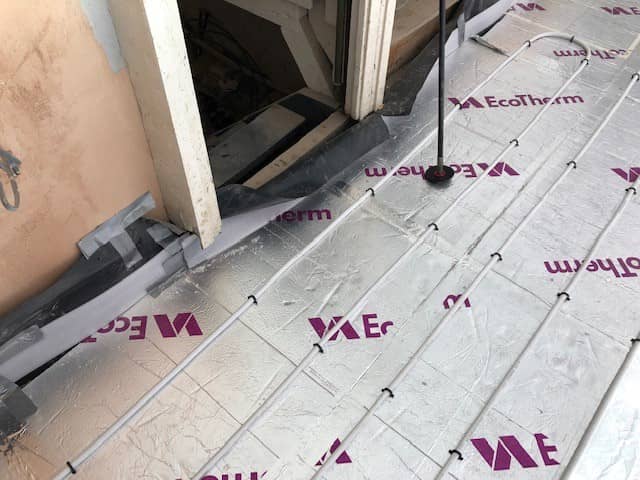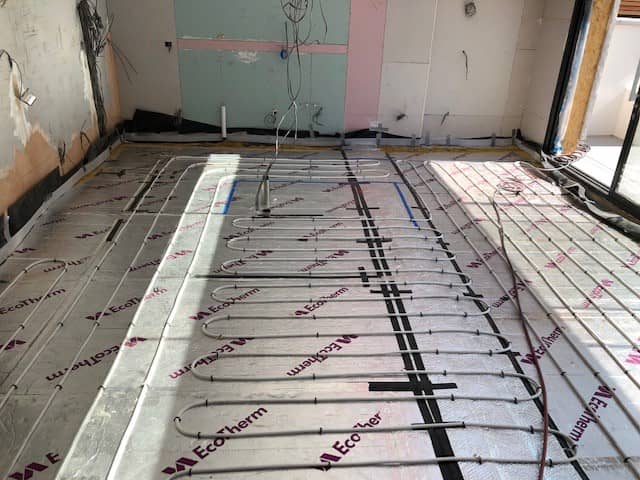Underfloor heating is a modern, efficient way to warm your home from the ground up, replacing bulky radiators with an invisible heat source beneath your flooring. By using either warm water pipes or electric elements, it provides an even, comfortable temperature while potentially lowering energy costs.
Thinking about upgrading your home heating system? At Maintracts Services, we have been installing and maintaining heating systems across London since 1974. Our Gas Safe registered engineers will ensure you get a system that suits your property and lifestyle. Call us on 02086822244 or email info@maintracts.co.uk to arrange a consultation today.
At Maintracts Services, we combine decades of hands-on expertise with advanced heating technology to deliver comfort, efficiency, and long-lasting results for every home we work on.
Understanding The Basics Of Underfloor Heating
Underfloor heating works by spreading heat evenly across your flooring surface, which then radiates into the room. Unlike traditional radiators, which rely on convection to heat the air, this method warms objects and people directly, creating a consistent temperature from floor to ceiling.
There are two main system types:
- Wet (Water-Based) Systems – Use a network of pipes connected to your boiler or heat pump to circulate warm water.
- Electric Systems – Use heating cables or mats that produce heat when powered.
Both systems can be used in new builds or as part of a renovation, but the choice depends on your budget, floor structure, and energy goals.
Also Read: Underfloor Heating Vs Radiators
How Does Underfloor Heating Work: A Step-By-Step Breakdown
To fully understand how underfloor heating works, it's important to look at each stage of the process, from the heat source to how warmth reaches you.
1. Heat Generation
- In wet systems, a boiler or renewable heat source (such as an air source or ground source heat pump) heats the water.
- In electric systems, an electrical current passes through resistance cables or mats, generating heat instantly.
2. Heat Distribution Network
- Wet systems use pipe circuits beneath the floor, arranged in loops for even coverage.
- Electric systems use mats or loose cables laid strategically for uniform heating.
3. Floor Insulation Layer
Beneath the heating elements or pipes, a layer of insulation prevents heat loss into the subfloor, ensuring more warmth stays in your living space and improving energy efficiency.
4. Heat Transfer Through Flooring
The heat moves from the pipes or cables into the floor surface. Materials like tile, stone, and laminate transfer heat more effectively than thick carpets.
5. Thermostat And UFH Controls
A smart thermostat or programmable UFH control panel regulates temperature in different heating zones, optimising energy use. This allows you to heat specific rooms when needed, reducing running costs.
6. Radiant Heating Effect
As the floor warms, heat radiates upwards, creating a comfortable, consistent environment. Unlike radiators, this avoids cold spots and keeps heat at a lower, more comfortable level.
7. Integration With Central Heating Systems
In many homes, underfloor heating works alongside a central heating system, with zone valves ensuring different areas are managed efficiently. For example, you may have underfloor heating in the kitchen and living area, but radiators in bedrooms.
Also Read: Why Is Your Underfloor Heating Not Working?
Additional Considerations For Underfloor Heating Systems
While the core process is similar for both wet and electric systems, there are practical aspects worth knowing before installation.
1. System Suitability
- Wet systems are best for large spaces and new builds, as installation involves significant floor work.
- Electric systems are ideal for smaller rooms, bathrooms, or retrofits due to their slimmer profile and faster installation.
2. Energy Efficiency
Underfloor heating typically runs at lower temperatures than radiators, making it more efficient. Wet systems paired with heat pumps are exceptionally eco-friendly.
3. Floor Covering Choices
Tile and stone are excellent conductors of heat, making them the most effective choice. Engineered wood and certain vinyls also work well, while thick carpets can reduce performance.
4. Maintenance Requirements
Electric systems generally require minimal upkeep, while wet systems benefit from periodic checks to ensure no air is trapped and the system pressure is correct.
5. Installation Process
Installing underfloor heating involves:
- Removing the existing flooring.
- Laying insulation.
- Installing pipe circuits or heating mats.
- Connecting to controls and power/heat source.
- Reinstalling the floor covering.
Also Read: Is It Better To Have Underfloor Heating On All The Time?
Set Up Energy-Efficient Heating With Maintracts Services
A well-installed underfloor heating system offers comfort, efficiency, and long-term reliability. At Maintracts Services, our specialists have decades of experience in designing and installing both wet and electric systems for London homes. Whether you want to integrate underfloor heating into a new build or retrofit it into an existing property, we can ensure it's done to the highest standard.
We provide complete support, from choosing the right system and materials to managing the complete installation and setting up your smart thermostat controls. Our work is fully compliant with industry regulations, and our engineers are Gas Safe registered for your peace of mind.
Ready to enjoy the comfort of warm floors all year round? Call us on 02086822244 or email info@maintracts.co.uk to book your consultation today.



FAQs
What are the main types of underfloor heating systems?
The two main systems are wet (water-based) and electric. Wet systems use heated water in pipes, while electric systems use heating mats or cables.
How is underfloor heating installed in existing homes?
Electric systems are easier to retrofit due to their thin profile. Wet systems may require raising floor levels and more preparation.
Can underfloor heating be used with all floor coverings?
Yes, but tiles, stone, and engineered wood work best. Carpet can be used if it's not too thick.
How energy-efficient is underfloor heating compared to radiators?
It's typically more efficient as it runs at lower temperatures and provides even heat distribution.
What are the typical running costs of underfloor heating?
Costs vary, but wet systems paired with renewable heat sources can be significantly cheaper to run long-term.
Is underfloor heating compatible with heat pumps?
Yes, especially wet systems, as they operate efficiently at lower water temperatures.
How does a thermostat control underfloor heating zones?
Smart thermostats can manage separate heating zones, allowing customised temperatures for each room.

